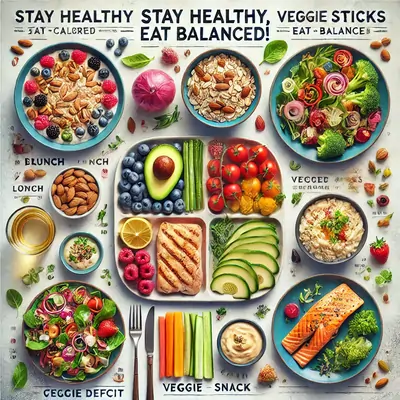
🥗 Meal Plan for Calorie Deficit: A Step-by-Step Guide to Achieving Your Goals
Losing weight through a calorie deficit is a proven strategy, and with the right meal plan, you can achieve your goals while still enjoying a variety of tasty and nutritious foods. The key to a successful calorie deficit is consuming fewer calories than your body needs to maintain its current weight. In this guide, we will help you craft a well-balanced meal plan that provides all the essential nutrients, keeps you full, and supports your weight loss journey.
Table of Contents
🧐 What Is a Calorie Deficit?
A calorie deficit occurs when you consume fewer calories than your body needs to maintain its current weight. The body uses stored fat as an energy source, leading to weight loss. To calculate your calorie deficit:
- Calculate your TDEE (Total Daily Energy Expenditure) – This is the number of calories your body burns daily.
- Subtract calories – Typically, a reduction of 500–1000 calories per day is recommended to lose 0.5 to 1 kg per week, which is considered safe and sustainable.
🍽️ Key Elements of a Balanced Meal Plan
When creating a meal plan for a calorie deficit, it’s essential to ensure that you’re still getting the necessary nutrients while keeping calories in check. Here are the key components of a well-rounded plan:
| Macronutrient | Why It’s Important | Examples |
|---|---|---|
| Protein | Helps preserve muscle mass, keeps you full | Chicken, turkey, tofu, fish, Greek yogurt |
| Healthy Fats | Supports brain function, balances hormones | Avocado, olive oil, nuts, seeds |
| Fiber-rich Carbs | Provides energy, aids digestion | Whole grains, fruits, vegetables |
| Hydration | Boosts metabolism, manages hunger | Water, herbal teas, infused water |
ADVERTISEMENT

🍽️ Example of a 1,500-Calorie Day Meal Plan
To help you get started, here’s a sample 1,500-calorie meal plan that is designed to keep you full, energized, and satisfied:
| Meal | Ingredients | Calories |
|---|---|---|
| Breakfast | ½ cup rolled oats, 1 cup mixed berries, 1 tbsp almond butter | 300 |
| Snack | ½ cup Greek yogurt, 1 tsp honey, 5 walnuts | 150 |
| Lunch | 3 oz grilled chicken, 2 cups greens, ½ avocado, 1 tbsp olive oil | 400 |
| Afternoon Snack | 1 cup veggie sticks (carrots, cucumbers), 2 tbsp hummus | 100 |
| Dinner | 4 oz baked salmon, ½ cup quinoa, 1 cup broccoli, 1 tsp olive oil | 450 |
| Evening Treat | 1 oz dark chocolate, ½ cup strawberries | 100 |
🥑 Meal Breakdown
🥞 Breakfast: Oats with Berries and Almonds (Approx. 300 Calories)
- ½ cup rolled oats (150 calories)
- 1 cup mixed berries (70 calories)
- 1 tbsp almond butter (80 calories)
This fiber-rich breakfast helps you feel full and energized for hours. The oats provide complex carbs, while the almond butter adds a boost of healthy fats and protein.
🍓 Mid-Morning Snack: Greek Yogurt with Honey (Approx. 150 Calories)
- ½ cup plain Greek yogurt (80 calories)
- 1 tsp honey (20 calories)
- A handful of walnuts (50 calories)
Packed with protein and healthy fats, this snack will keep hunger at bay until lunchtime.
🥗 Lunch: Grilled Chicken Salad with Avocado (Approx. 400 Calories)
- 3 oz grilled chicken breast (165 calories)
- 2 cups mixed greens (10 calories)
- ½ avocado (120 calories)
- 1 tbsp olive oil for dressing (120 calories)
A balanced meal with lean protein, fiber, and healthy fats that will keep you full and energized.
🥒 Afternoon Snack: Veggie Sticks with Hummus (Approx. 100 Calories)
- 1 cup cucumber and carrot sticks (25 calories)
- 2 tbsp hummus (75 calories)
A refreshing and satisfying snack that’s low in calories but high in nutrients.
🍣 Dinner: Baked Salmon with Quinoa and Steamed Broccoli (Approx. 450 Calories)
- 4 oz baked salmon (230 calories)
- ½ cup cooked quinoa (110 calories)
- 1 cup steamed broccoli (50 calories)
- 1 tsp olive oil (40 calories)
This dinner is packed with omega-3 fatty acids, protein, and complex carbs, making it a filling and nutritious option.
🍫 Evening Treat: Dark Chocolate and Strawberries (Approx. 100 Calories)
- 1 oz dark chocolate (70% cacao) (70 calories)
- ½ cup fresh strawberries (30 calories)
Enjoy a small indulgence with antioxidant-rich dark chocolate paired with fresh, vitamin-rich strawberries.
ADVERTISEMENT

📋 Practical Tips for Sticking to Your Calorie Deficit Plan
| Tip | Description |
|---|---|
| Meal Prep | Prepare meals in advance to avoid reaching for unhealthy foods when hungry. |
| Focus on Whole Foods | Choose minimally processed foods for better satiety and nutritional value. |
| Eat Mindfully | Slow down and listen to your body’s hunger and fullness cues. |
| Hydrate | Drink water regularly to stay hydrated and prevent mistaking thirst for hunger. |
🍵 Hydration Tips
Drinking enough water is crucial when you’re following a calorie deficit. Water aids in digestion, keeps your metabolism active, and helps you stay full between meals. Aim for at least 8 glasses of water a day. You can also infuse your water with lemon, cucumber, or mint for added flavor without the extra calories.
🍎 Smart Food Swaps for a Calorie Deficit
To maintain your calorie deficit without feeling deprived, consider these healthy food swaps:
| Instead of… | Try… | Why? |
|---|---|---|
| White bread | Whole grain bread | More fiber and nutrients, keeps you fuller longer |
| Sour cream | Greek yogurt | Higher in protein and lower in calories |
| Chips | Air-popped popcorn | Fewer calories, more volume |
| Sugary soda | Sparkling water with lemon | No sugar and calories |
| White rice | Cauliflower rice | Fewer carbs and calories, more nutrients |
🎯 Key Takeaways
- Consistency is key – Stick to your plan for long-term success.
- Focus on whole foods – They’re more filling and nutrient-dense.
- Protein matters – Include protein in every meal to maintain muscle mass and satiety.
- Stay hydrated – Drinking enough water boosts your metabolism and curbs unnecessary snacking.
- Healthy fats – Don’t skimp on fats; they help keep you full and support hormone function.
- Meal prep – Preparing meals ahead saves time and prevents unhealthy food choices.
- Listen to your body – Adjust portion sizes based on your activity levels and hunger.
- Monitor progress – Track your food intake to ensure you’re in a calorie deficit.
- Enjoy small treats – Don’t deprive yourself entirely; it helps maintain sustainability.
- Stick to portion control – Ensuring portion sizes are correct is key to staying within your calorie deficit.
🏁 Conclusion
A calorie deficit meal plan doesn’t have to feel restrictive. By focusing on balanced, nutrient-dense meals and healthy portion sizes, you can effectively lose weight while enjoying a variety of delicious foods. Remember, the key is consistency, mindful eating, and adjusting your plan to suit your lifestyle and progress. Start with this meal plan, make it your own, and watch the transformation happen!
💪 Ready to start your journey? Let’s get cooking! 🍳
🤔 Frequently Asked Questions (FAQs)
How many calories should I eat to be in a calorie deficit?
It depends on your Total Daily Energy Expenditure (TDEE). Typically, subtracting 500-1000 calories from your TDEE is recommended for a sustainable weight loss of 0.5 to 1 kg per week.
Can I eat carbs on a calorie deficit?
Yes! It’s important to include fiber-rich, whole carbs like oats, quinoa, and sweet potatoes for energy and fullness.
Do I have to track my calories?
Tracking calories can be helpful, especially when starting out. It helps ensure you’re staying within your calorie deficit.
What are good snacks for a calorie deficit?
Greek yogurt, boiled eggs, veggie sticks with hummus, and fresh fruit are great low-calorie snacks.
Can I exercise while on a calorie deficit?
Yes! Exercise can help you increase your calorie burn and improve muscle mass retention while in a calorie deficit.
How fast will I lose weight on a calorie deficit?
On average, with a calorie deficit of 500-1000 calories per day, you can expect to lose about 0.5 to 1 kg per week. Keep in mind that individual results can vary.
What should I do if I stop losing weight on a calorie deficit?
If your weight loss stalls, it could be due to a decrease in your TDEE as you lose weight. You may need to adjust your calorie intake, increase your physical activity, or reassess portion sizes.
Is it safe to be in a calorie deficit long-term?
A moderate calorie deficit is generally safe for most people. However, long-term deficits should not be too extreme, as they can lead to nutrient deficiencies or muscle loss. Consult with a healthcare professional for personalized advice.
Can I have cheat days while in a calorie deficit?
Yes, occasional cheat meals or days can fit into a balanced approach to dieting. Just be mindful that too many cheat days can offset the calorie deficit and slow progress.
How do I avoid feeling hungry while on a calorie deficit?
Focus on eating high-volume, low-calorie foods like vegetables, lean proteins, and fiber-rich grains. Drinking water before meals and eating slowly can also help manage hunger.
ADVERTISEMENT

We Also Recommend:
- JILIVIP App
- JILIVIP Bonus
- JILIVIP Login
- GXGWin Casino
- GXGWin Bonus
- GXGWin Register
- PHWin Login
- PHWin Bonus
- PHGinto
- JK4 Casino Online
- GXGWin App
- 9KSLOT Casino
- WinPH Casino
- 88Casino Royale
- PHGinto Login
- GXGWin Login
- 9KSLOT Login
- PHRoyal777 Casino
- YAMAN777 Gaming Casino
- GXGWin Register
KEYWORDS: Meal Plan

Ghen is a skilled SEO specialist in the online gaming industry, known for boosting organic traffic and engagement. With expertise in keyword research, content optimization, and link building, she helps gaming platforms achieve and maintain top search rankings.






